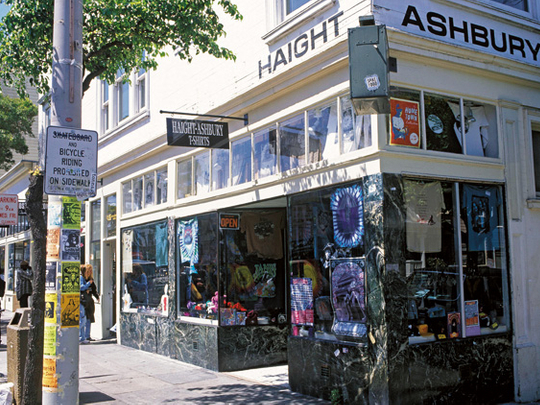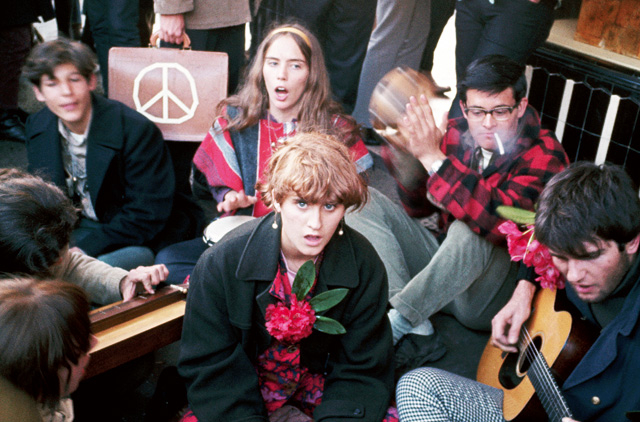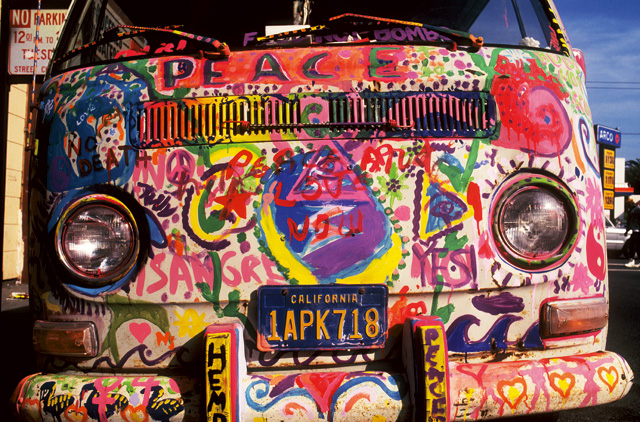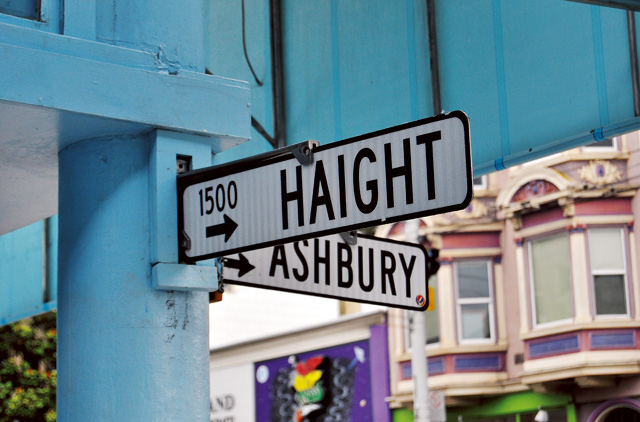
Longish hair, wispy sideburns, outré clothing of unlikely colours, an overall scruffy aesthetic. The hippie fashions of San Francisco's Haight-Ashbury district evoked less than amorous feelings in my grandparents as they found themselves at the epicentre of the Summer of Love. But here's something that is often lost in Hollywood depictions of that storied season: the hippies weren't yet all that hippie-like.
Long hair among males reached just below the ears. It would take another two years for anyone to grow their hair out to the lengths seen at Woodstock. Still, the intersection of Haight and Ashbury was a cultural crossroads in 1967. It had the power to shock a nation.
Cecil and Marguerite Howland had come to San Francisco for a week in June of 1967 to attend the American Library Association Conference. Academic librarians by trade, Cecil and Marguerite lived a surprisingly cultured life in Stillwater Oklahoma, where their peer group included more than a few close friends who had come from the Indian subcontinent to study at Oklahoma State University. Years earlier they had happily dressed my mother in the vibrant saris she received as gifts, and yet the faded denim, feather-bedecked hats and suede vests of hippiedom were worrisome to the studious pair.
The Haight, as it came to be known, was an ongoing national news phenomenon that year and the unlikely duo, joined by their daughter, were compelled to view the now infamous neighbourhood from the safety of an enormous Chrysler estate. My mother, a teenager at the time, had the exact opposite reaction to the denizens of the Haight: she was enthralled by the seemingly international cool of the strangely clad San Franciscans, whose cutting-edge style and (sometimes half-baked) philosophy wouldn't arrive in Oklahoma for several years, if at all. In some ways, you can trace my very existence back to this moment, when my mom first felt the pull of San Francisco's burgeoning bohemian reputation. Several years later mom would move to the city and begin the life that led to my birth in a small town, some 48km north of San Francisco's iconic Golden Gate Bridge. You could say I owe my life to the Haight, although there are certainly other factors.
Approaching that same bridge on one recent morning, its vermillion orange towers are almost completely shrouded in fog, giving one the feeling of driving directly into a cloudbank. Like its singular culture, the city of San Francisco is a weather system unto itself. Often gloriously sunny by summer day, the weather turns cold in a matter of minutes leaving you to wish you'd packed a jumper or two. But this day, as I ease my car to one of the Haight's rare parking spots, the sky remains fogged and cool all day, quietly announcing the arrival of autumn.
Perhaps the greatest legacy of Haight-Ashbury activism is embodied by the Haight Ashbury Free Clinics, the free health care services that are open to people from all walks of life, hippie or otherwise. But eight out of ten patients live below the US poverty line. In preparation for the huge influx of ‘flower children' in 1967, the clinics were established to help the thousands of young people on the street in the Haight Ashbury district, many of whom eschewed both work and material things. From a collective impulse to operate outside what was perceived as an authoritarian mainstream culture, the early hippie movement attempted to look after those who weren't - to put it lightly - preoccupied with earning a buck.
From this more innocent and idealistic time, the Haight would eventually become a haven for drug and alcohol abuse, homelessness, and an aggressive brand of panhandling. While today's Haight Street still entertains, echoes of its hippie past — the odd Jimi Hendrix mural here, an oversized peace sign there — it is one of San Francisco's main shopping districts. It has one of the city's largest record stores, numerous vintage-clothing shops, second-hand stores, exclusive boutiques, and sundry restaurants featuring an array of cuisines that might be at home in cosmopolitan Dubai. As the retailers increased in numbers, with big corporations like Gap and Ben and Jerry's securing prime locations along Haight, panhandlers did the same.
"Sir, excuse me sir." A blond, dreadlocked kid surrounded by a gang of similarly coiffed confederates, is charging towards a businessman who has just finished a call on his mobile phone. "Can I use your phone? I need to use your phone." The kid's tone is loud, over-friendly, and slightly menacing. This is the other legacy of the 1960s, the ‘trustafarian' whose privilege and access to family money props up a lifestyle of faux hippie loafing and scrounging. There's no way to know what this phone-less youth's real economic situation is, but he's clearly in a financial category somewhere north of the two actual homeless men who are stationed all day at the corner of Haight and Ashbury. Real poverty is glaring and easy to spot. The trustafarian and his cohorts have the look of elective, or semi-poverty. Simply put they all appear to have bathed this week. I keep walking briskly as I have no intention of lending anyone my phone unless it's a real emergency.
In its heyday, the Haight was known for its music—The Grateful Dead spent several years living, playing, and learning to tune (sort of) at 710 Ashbury. Today the large Victorian house is freshly painted in almost grey shades of violet. It's hard to imagine this conservative looking home was once at the centre of the Haight's music scene. There's not much more than the din of city traffic as I walk by and I suspect that rent would be untenable to all but the most successful musicians.
Jefferson Airplane also called the Haight home as they ascended the pop charts, but no one seems to know, or care, where they lived. The fanatical following of Deadheads, even 16 years after the death of Grateful Dead bandleader Jerry Garcia, is unmatched in popular music. In its own way, this is one of the neighbourhood's most enduring legacies; an undying love for an almost mythic band that, most critics agree, never really captured its full impact in the recording studio. To be fair, the Dead did manage to squeeze out their only chart-topping song in 1987, a full 20 years after the summer of love. As if to reiterate the neighbourhood's musical history I spot a tiny Grateful Dead sticker, featuring the bands iconic skull and lightning bolt logo, affixed to the Ashbury Street sign at the neighbourhood's most famous intersection.
There are still remnants of the old Haight, and as I take respite in the threadbare atmosphere of the Red Vic Movie House Café I feel as if I'm in some university town without a university. The Haight's legacy of addiction is never far away and as I'm sipping my coffee an employee is summoned to determine if there's someone passed out in the theatre's restroom. Luckily it's a false alarm and I spend the rest of my time pursuing the movie listings. I decide to pass on the day's feature, a 1972 screwball comedy starring Barbra Streisand, and return to the cool of Haight street no less appreciative of the fact that there actually is a place where one can go and watch a 1972 screwball comedy, Streisand aide.
Stumbling back towards Ashbury with half a mind to call it a day, I discover the true soul of modern day Haight Street: a scruffy bluegrass band known as The Jugtown Pirates who spend the day busking on their cage-like front stoop before setting off for whatever music venue is hosting their furious sound that evening. "From the cage to the stage!" grins Paul ‘Mendlesohn' Girouard, the group's puckish mandolin player. "We could do this in other neighbourhoods, explains Josh Brough, the band's ginger bearded bass player, "but the Haight is definitely the best place to be doing it - all kinds of people walk by."
With that, the Pirates rip into Sierra Girl, a whirling tune about a young lady from California's gorgeous mountain region, replete with melodic fiddling and lightning mandolin. People stop and listen as camera-laden tourists queue up to shoot the band. This is another fact worth noting; every other person I see is sporting a camera. Clearly the Haight has continued to draw curious onlookers since that summer long ago when my family first drove down this street.
I came to the Haight wondering if I'd find any trace of the generosity and musicality that the neighbourhood embodied in the Sixties. Here, at the steps of a humble walk-up apartment, I find real music, made from the heart and given away for free. If you want to drop a dollar in the guitar case, the boys are more than happy to have it, but unlike the trustafarians down the block, they'll never brow-beat you into forking out cash, or your phone. I don't get the sense that these fellows consider themselves hippies per se, but it might not be a coincidence that they're playing Bluegrass, an idiom of music long favoured by Jerry Garcia — though not in his psychedelic guise. Like its most famous former denizen, the Haight still shows its roots; even if you have to dig a little to find them.
Where to stay
The Red Victorian Bed and Breakfast
A striking red-faced building in the heart of Haight-Ashbury and well-served by public transport. From $75 (Dh275) per night.
www.redvic.com
Ocean Park Motel
An art deco-themed hotel in the neighbouring Sunset District. From $100 per night.
www.oceanparkmotel.com
Stanyan Park Hotel
An awarding-winning, affordable hotel next to the Golden Gate Park, close to Haight-Ashbury. From $155.
www.stanyanpark.com
Emirates flies direct to San Francisco from around Dh7,800
















